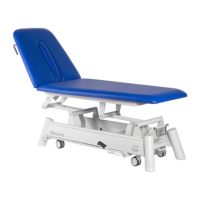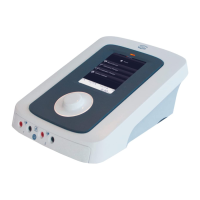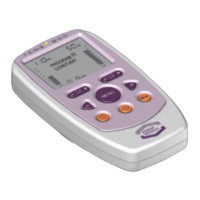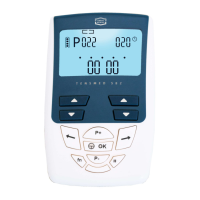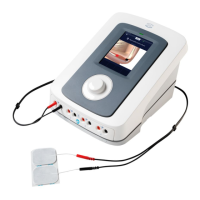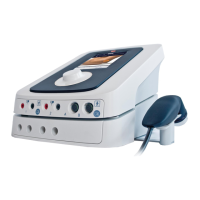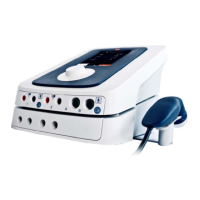1600751-4D
4.3.2.b Burst Asymmetrical and Burst Alternating Asymmetrical
The burst biphasic and burst biphasic alternating asymmetrical pulsed currents are variations to
their non burst counterparts, in which the continuous train of pulses is interrupted by pulse
pauses. See fig 13.1.3 and fig 13.1.4 for details. A burst frequency can be set for treating
chronic pains, where the use of continuous stimulation with a low pulse frequency would be too
painful. Each burst lasts for 100ms and the burst rate can be adjusted separately. With this
milder TENS waveform it is easier to exceed the motorial threshold stimulus.
Parameters:
Phase Duration, expressed in µs, is the elapsed time from the beginning to the termination of
the initial pulse phase. See fig 13.1 for details.
Pulse Frequency, expressed in Hz or pps (pulses per second), defines the repetition rate of the
TENS pulses. See fig 13.1 for details.
Burst Frequency, expressed in Hz, defines the repetition rate of bursts of pulses. A burst
consists of a train of pulses. Each burst lasts for 100ms and the number of pulses in a burst
depends on the selected Pulse frequency i.e at a Pulse Frequency of 100Hz, 10 pulses are
available in each burst. Burst mode can not be selected when Frequency modulation is active.
See fig 13.1.3 for details.
4.3.2.c Symmetrical
TENS current pulses can also be used for muscle stimulation applications. Often the
symmetrical biphasic pulsed current waveform is used. See fig 13.1.5 for a graphical
representation. The specified phase duration applies to both pulse phases, which doubles the
amount of available energy with respect to the asymmetrical pulsed current waveform. This
waveform is fully balanced (no residual DC components are present).
Parameters:
Phase Duration, expressed in µs, is the elapsed time from the beginning to the termination of a
pulse phase. The phase duration applies to each pulse phase. See fig 13.1.5 for details.
Phase Interval, expressed in µs, is the elapsed time between the positive and the negative
pulse phase. See fig 13.1.5 for details.
Pulse Frequency, expressed in Hz or pps (pulses per second), defines the repetition rate of the
TENS pulses. See fig 13.1.5 for details.
Frequency Modulation, expressed in Hz, defines a variable frequency range that is summed to
the Beat frequency i.e when the Beat frequency is set to 80 Hz and the Frequency modulation is
set to 40 Hz, the final frequency will vary from 80 – 120 Hz.
Modulation Program defines the time and sequence in which the frequency will sweep through
the Frequency modulation range. See for the available Modulation programs fig 13.11 –
13.11.3.
Surge Program can be used to adjust repeated sequences of contraction and rest periods. See
paragraph 11.2.11.a for details.
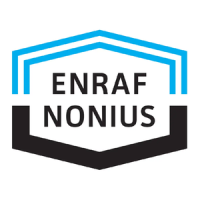
